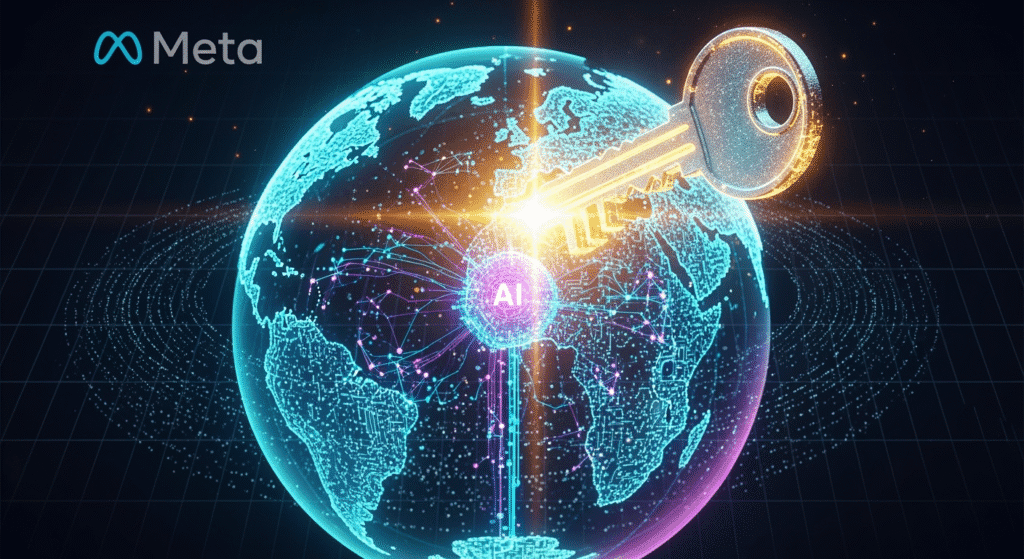A New Chapter in Vision AI
Meta has taken another bold step in artificial intelligence. The company announced the release of DINOv3, its state-of-the-art vision model, opening the doors for commercial projects worldwide. Unlike earlier AI tools that required massive amounts of labeled data, DINOv3 thrives without it. It learns directly from raw images, spotting patterns and understanding visual concepts much like humans do.
This move isn’t just about research papers. It’s about giving startups, enterprises, and developers access to a powerful tool that can revolutionize industries. From healthcare diagnostics to retail automation, the potential applications are immense.
Meta has positioned DINOv3 as more than just another model. It’s a flagship example of self-supervised learning a technique that could redefine how machines interpret the world.
The Technology Behind DINOv3
At its core, DINOv3 is built on self-supervised learning and transformer architectures. Unlike older models that needed labeled datasets where humans tagged millions of images DINOv3 extracts knowledge by simply observing.
The model leverages contrastive learning techniques, comparing image representations across multiple views. It learns structure, texture, and even abstract concepts without human supervision. The result? A system that’s surprisingly good at tasks like object recognition, segmentation, and scene understanding without being explicitly trained for them.
Meta’s AI team highlighted that this is the third generation in the DINO line, improving scalability and efficiency while handling increasingly complex datasets. It’s designed to generalize well across industries, making it versatile for both research and production environments.
From Research to Real-World Applications
The release of DINOv3 for commercial use signals a major shift. Companies can now integrate cutting-edge computer vision into their products without building models from scratch.
Healthcare companies could use it to detect anomalies in medical scans. Retailers could build smarter checkout systems that recognize products instantly. Environmental researchers might track deforestation or ocean pollution at scale. Even creative industries stand to benefit, with AI-driven image editing, content moderation, and generative design tools powered by DINOv3.
By lowering barriers, Meta ensures that not only tech giants but also smaller innovators can experiment with world-class AI.
Why Self-Supervised Learning Matters
Self-supervised learning is often described as the future of AI training. Traditional supervised methods rely on costly, time-consuming human annotations. For example, labeling millions of medical images or street scenes takes months of effort.
With DINOv3, machines learn by themselves. The model analyzes raw images and identifies consistent patterns, much like how a child learns to recognize objects without being explicitly told every detail. This makes the model far more scalable and adaptable.
It’s not limited to just one domain. A single trained model can perform well across multiple applications, from biology to urban planning. That’s a significant step toward more generalized AI systems.
Meta’s Strategy: Open Access to AI

One of the most striking elements of this announcement is Meta’s decision to release DINOv3 openly for commercial projects. While many companies guard their AI breakthroughs behind proprietary walls, Meta has repeatedly chosen open science.
This aligns with Meta’s broader strategy. By making models like DINOv3 widely available, Meta fuels global AI adoption and accelerates innovation. It also positions the company as a thought leader in AI research transparency, standing apart from competitors who often restrict access.
Critics argue this could spark misuse. But Meta insists that open collaboration is the fastest way to push AI forward.
The Business and Market Implications
Investors are watching closely. Meta’s announcement quickly made headlines in financial outlets like Investing.com, framing DINOv3 as a potential driver of future growth.
The commercial availability means industries can adopt the model without the enormous upfront cost of training. This could create an ecosystem of AI-powered services and products that indirectly benefit Meta’s influence in the tech landscape.
For startups, the opportunity is huge. Many small firms don’t have the money or resources to train models on billions of images. With DINOv3, they can plug into a ready-to-use foundation and focus on building specialized solutions. This levels the playing field in ways that could spark a new wave of AI-driven businesses.
For larger enterprises, DINOv3 represents efficiency. A logistics company could deploy it to track goods across warehouses. A streaming platform could enhance content moderation at scale. Even governments might tap into its power for urban planning or public safety initiatives.
There’s also a competitive angle. Meta is positioning itself as a global provider of open AI resources, directly challenging Google’s DeepMind and OpenAI. By giving away cutting-edge technology, Meta strengthens its ecosystem, draws developers closer, and cements itself as a cornerstone of the AI revolution.
The stock market sees this as a long-term play. It may not generate immediate revenue like ad sales, but it builds a future foundation where Meta becomes synonymous with AI infrastructure, much like Amazon with cloud computing.
Challenges, Risks, and Ethical Questions
Of course, no breakthrough comes without concerns. Self-supervised models are powerful, but they can also amplify biases in data. If DINOv3 learns from flawed or imbalanced datasets, its decisions may reflect those issues. For instance, underrepresented groups in training data could lead to misidentifications or blind spots.
There’s also the risk of misuse. Powerful vision models could be applied in surveillance, deepfake generation, or privacy-invading tools. In regions with weak regulation, such misuse could spread rapidly. Critics worry that open access means bad actors gain the same opportunities as innovators.
Meta acknowledges these concerns and emphasizes responsible use. The company has published extensive documentation, model cards, and guidelines. But whether those guardrails are enough remains an open question.
On the technical side, scalability and compute costs still matter. Running DINOv3 requires significant hardware resources. Smaller companies may find access easier in theory than in practice, especially if they lack cloud infrastructure.
The balance between open access and responsible control is still fragile. This tension will likely define debates around DINOv3 in the years ahead.
Future Outlook: What’s Next for Vision AI
Looking forward, DINOv3 is just the beginning. Experts believe this model sets the stage for multi-modal AI systems ones that can understand not just images, but also video, audio, and text together.
Meta has already hinted at combining DINOv3 with large language models. The result could be systems capable of contextual reasoning across media types. Imagine a doctor using AI that not only analyzes an MRI scan but also reviews relevant research papers and generates a summary recommendation. Or a journalist uploading a photo and instantly receiving a fact-checked contextual background.
The implications for autonomous systems are equally significant. Self-driving cars could integrate DINOv3-like models to improve their perception of the road. Agricultural drones could analyze fields in real time. Smart cities could manage traffic, pollution, and infrastructure through AI-powered monitoring.
But the most exciting prospect is the march toward generalist AI. Unlike today’s fragmented systems one model for language, another for images, another for sound future systems may combine them seamlessly. DINOv3, with its self-supervised foundation, provides the blueprint for this shift.
If Meta stays the course, it won’t just be competing with other tech giants. It will be shaping the very direction of artificial intelligence.
Conclusion The Bigger Picture

Meta’s release of DINOv3 is more than a technical achievement. It’s a statement about the future of AI one where machines learn like humans, industries accelerate innovation, and knowledge spreads beyond corporate silos.
Will it reshape markets overnight? Probably not. But it plants the seeds for a new generation of applications, tools, and opportunities.
For businesses, researchers, and developers, the message is clear: the age of self-supervised AI is here. And Meta wants to lead the way.
Sources
- Meta makes its state-of-the-art DINOv3 image analysis model available for commercial projects – The Decoder
- Meta looks further: DINOv3 reads images without manual labeling – TurtlesAI
- Meta AI Blog: DINOv3 self-supervised vision model
- Meta introduces DINOv3: a breakthrough in self-supervised vision AI – Investing.com










Comments 2